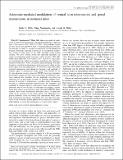Files in this item
Adenosine-mediated modulation of ventral horn interneurons and spinal motoneurons in neonatal mice
Item metadata
| dc.contributor.author | Witts, Emily Charlotte | |
| dc.contributor.author | Nascimento, Filipe | |
| dc.contributor.author | Miles, Gareth Brian | |
| dc.date.accessioned | 2015-10-21T16:10:00Z | |
| dc.date.available | 2015-10-21T16:10:00Z | |
| dc.date.issued | 2015-10 | |
| dc.identifier | 211967896 | |
| dc.identifier | eb20004c-3697-4a0d-acb3-19f9d04ebcba | |
| dc.identifier | 84945198363 | |
| dc.identifier | 000363548300024 | |
| dc.identifier.citation | Witts , E C , Nascimento , F & Miles , G B 2015 , ' Adenosine-mediated modulation of ventral horn interneurons and spinal motoneurons in neonatal mice ' , Journal of Neurophysiology , vol. 114 , no. 4 , pp. 2305-2315 . https://doi.org/10.1152/jn.00574.2014 | en |
| dc.identifier.issn | 0022-3077 | |
| dc.identifier.other | ORCID: /0000-0002-8624-4625/work/29135003 | |
| dc.identifier.uri | https://hdl.handle.net/10023/7682 | |
| dc.description | The authors are grateful for support from the Wellcome Trust. | en |
| dc.description.abstract | Neuromodulation allows neural networks to adapt to varying environmental and biomechanical demands. Purinergic signalling is known to be an important modulatory system in many parts of the CNS, including motor control circuitry. We have recently shown that adenosine modulates the output of mammalian spinal locomotor control circuitry (Witts et al., 2012). Here we investigated the cellular mechanisms underlying this adenosine-mediated modulation. Whole-cell patch-clamp recordings were performed on ventral horn interneurons and motoneurons within in vitro mouse spinal cord slice preparations. We found that adenosine hyperpolarised interneurons and reduced the frequency and amplitude of synaptic inputs to interneurons. Both effects were blocked by the A1-type adenosine receptor antagonist DPCPX. Analysis of miniature post-synaptic currents recorded from interneurons revealed that adenosine reduced their frequency but not amplitude, suggesting adenosine acts on presynaptic receptors to modulate synaptic transmission. In contrast to interneurons, recordings from motoneurons revealed an adenosine-mediated depolarisation. The frequency and amplitude of synaptic inputs to motoneurons was again reduced by adenosine, but we saw no effect on miniature post-synaptic currents. Again these effects on motoneurons were blocked by DPCPX. Taken together, these results demonstrate differential effects of adenosine, acting via A1 receptors, in the mouse spinal cord. Adenosine has a general inhibitory action on ventral horn interneurons while potentially maintaining motoneuron excitability. This may allow for adaptation of the locomotor pattern generated by interneuronal networks while helping to ensure the maintenance of overall motor output. | |
| dc.format.extent | 1668690 | |
| dc.language.iso | eng | |
| dc.relation.ispartof | Journal of Neurophysiology | en |
| dc.subject | Spinal cord | en |
| dc.subject | Motor control | en |
| dc.subject | Neuromodulation | en |
| dc.subject | Purines | en |
| dc.subject | RC0321 Neuroscience. Biological psychiatry. Neuropsychiatry | en |
| dc.subject | NDAS | en |
| dc.subject.lcc | RC0321 | en |
| dc.title | Adenosine-mediated modulation of ventral horn interneurons and spinal motoneurons in neonatal mice | en |
| dc.type | Journal article | en |
| dc.contributor.sponsor | The Wellcome Trust | en |
| dc.contributor.institution | University of St Andrews. School of Psychology and Neuroscience | en |
| dc.contributor.institution | University of St Andrews. Institute of Behavioural and Neural Sciences | en |
| dc.identifier.doi | 10.1152/jn.00574.2014 | |
| dc.description.status | Peer reviewed | en |
| dc.identifier.grantnumber | 097831/z/11/z | en |
This item appears in the following Collection(s)
Items in the St Andrews Research Repository are protected by copyright, with all rights reserved, unless otherwise indicated.

